Abstract
The remote monitoring of clinical parameters plays a fundamental role in different situations, like pandemic health emergencies and post-surgery conditions. In these situations, the patients might be impeded in their movements, and it could be difficult to have specific health monitoring. In recent years, technological advances in smartphones have opened up new possibilities in this landscape. The present work aims to propose a new method for respiratory kinematics monitoring via smartphone sensors. In particular, a specific application was developed to register inertial measurement unit (IMU) sensor data from the smartphone for respiratory kinematics measurement and to guide the user through a specific acquisition session. The session was defined to allow the monitoring of the respiratory movement in five prescribed positions. The application and the sequence were successfully tested on a given population of 77 healthy volunteers. The resulting accelerometers and gyroscope signals were processed to evaluate the significance of differences according to participants’ sex, vector components, and smartphone positioning and, finally, to estimate the respiratory rate. The statistical differences that emerged revealed the significance of information in the different acquisition positions.
1. Introduction
The importance of remote monitoring of health parameters has risen in recent years [1]. Thanks to technological advances in the fields of medicine, informatics, and engineering, there has been a rapid growth of technologies capable of providing tools for remote monitoring of subjects or patients in different ways [2]. The target of these applications is represented by people with limited mobility or those forced to remain home (e.g., bedridden patients). This aspect acquired even more relevance after the pandemic emergency in recent years, which was linked with an increasing development of such health monitoring methods [3,4]. The monitoring methods can be multiple in nature: audio, video, or biomedical signals in a more general sense. Examples are given by the remote monitoring of ECG signals [5,6], heart rate [7], and others. Currently, there are many integrated “smart” systems, such as smartwatches and smartphones, that can be used to obtain real-time information on lifestyle and health status in a non-invasive way.
In this landscape, smartphones play a critical role. This is demonstrated by the rising number of commercial and non-commercial smartphone applications aimed at acquiring and analyzing generic biomedical signals, promoting an increasing number of actual clinical trials. An example is given by the Apple Heart Study born from the partnership of Apple, Inc., and Stanford University [8]. Starting from these experiences, during the pandemic, we have witnessed a further growth of such devices and applications aimed precisely at the remote monitoring of COVID-19 patients [9]. In this particular context, smartphone systems can play a fundamental role in fulfilling two intrinsically related aspects: guaranteeing the safety and health of the domestic population and systematically monitoring isolated subjects remotely. Nowadays, the monitoring of vital functions through smartphones is made possible thanks to numerous integrated transducers: high-resolution cameras, geolocation sensors, accelerometers, gyroscopes, magnetometers, ambient light sensors, and microphones [10,11]. Examples are given by the works of Brown et al. [12] and Kvapilova et al. [13], in which applications were developed to record cough sounds through the smartphone microphone to remotely diagnose infections via artificial intelligence algorithms.
The studies in the research literature demonstrate how these instruments, capable of providing biomedical information, are a powerful tool for prevention and monitoring of public health for impeded patients. Beyond the needs imposed by pandemics, it is relevant to underline that these instruments also play a key role in monitoring rehabilitation conditions for patients who underwent surgery interventions [14]. An example is given by the work of Halloran and colleagues, in which a population of stroke patients was successfully monitored via wearable accelerometer sensors for rehabilitation [15].
The current drawback of smartphone-based systems is the limited nature of the biomedical signals that can be provided, regardless of their embedded sensor technology. An example is given by respiratory kinematics. It is in fact fundamental to underline how the respiratory act is linked with complex kinematics that are much more extensive than the information reported by a single one-dimensional pattern [16]. The corresponding respiratory pattern should therefore be characterized by a four-dimensional dynamic system (three-dimensional space and time) where the spatial component responds not only to the excursion of the rib cage with its respiratory frequency, but also to the way in which the rib cage and the diaphragm allow the acts of inhalation and exhalation. The study of chest wall kinematics during the respiratory act has relevance in different health contexts [17,18], including rehabilitation after surgery [19]. Previous contributions reported the relevance of chest wall movement for respiratory function, due to the link between ventilation and diaphragm motion when chest expansion is impaired as a consequence of surgery [20]. Weakening of chest wall muscles increases the risk for postoperative pulmonary complications with consequent further impairment of pulmonary function [21]. In some cases, chest wall movement and pulmonary function in patients who underwent cardiac surgery revealed an asymmetric respiratory movement and an anomalous breathing pattern three months after the intervention when compared with preoperative values [22]. In the literature, accelerometer measurements for respiratory kinematics at the chest and abdomen level have already been reported [23,24,25], with successful results in different contexts. From the literature, it appears that mostly wearable systems with standalone sensors and wireless communication have been used [26,27], with few works proposing smartphones for respiratory rate monitoring [28,29]. Moreover, an overall kinematic evaluation correlated to the chest–abdominal device position has not been reported. The adoption of standalone and wearable transducers presents drawbacks in terms of hardware power consumption and usability, while smartphone-embedded sensor results are more suitable, given their wide availability. To our knowledge, an acquisition protocol to evaluate complete respiratory kinematics, including the chest and abdomen, via smartphone-embedded IMUs is still lacking.
In this context, the current paper proposes a new smartphone-based method for respiratory kinematics assessment, with the development of an application dedicated for the remote monitoring of patients. The main idea behind this work is the definition of an acquisition protocol with a new application for the evaluation of chest–abdomen respiratory kinematics via embedded inertial measurement unit (IMU) sensors. In this manuscript, the method feasibility will be demonstrated by first presenting a validation procedure of the monitoring system. After the validation, a dedicated application will be developed and described. Then, a measurement campaign with the above-cited application, involving healthy volunteers, will be defined, and the resulting accelerometer–gyroscope signals will be processed. Finally, the results will be discussed considering the signal differences in the considered population.
2. Materials and Methods
In this section, the validation of the accelerometer–gyroscope measurements will be described first, and then the application development will be characterized. Finally, the signal processing procedure and the acquisition campaign will be explained.
2.1. Validation
Measurements from the smartphone-embedded IMU sensors were validated first. Firstly, an acquisition procedure was defined to evaluate the feasibility. A sample of 10 healthy volunteer subjects (31 ± 1.5 and 30 ± 2.2 years old, BMI of 22.9 ± 4.0 and 19.5 ± 3.9, for 4 males and 6 females, respectively) were involved for the preliminary data recording protocol. Different smartphone positioning configurations were defined to fully explore respiratory kinematics at both the chest and abdomen levels. It is, in fact, established that the respiratory act generates complex kinematics at the rib cage level [30]. Figure 1 shows the summary of the movements of the rib cage and diaphragm during the respiratory cycle. As can be seen, the kinematics include multiple degrees of freedom in three-dimensional space, also considering the movement imposed by diaphragm compression [31,32].

Figure 1.
Summary of rib cage kinematics during the respiratory act, including diaphragm compression.
On the basis of this evidence, configurations to explore respiratory kinematics were established with clinicians’ support, as summarized in Figure 2a,b. Briefly, five configurations were identified with two possible orientations of the smartphone, i.e., vertical (Figure 2a) and horizontal (Figure 2b), for a total of 10 cases. The five configurations are given by:
- Position 1—right side of chest ();
- Position 2—left side of chest ();
- Position 3—chest center ();
- Position 4—upper abdomen ();
- Position 5—lower abdomen ().
Data acquisition from the smartphone-embedded IMUs was performed with a dedicated application for this preliminary validation phase. For each of the defined positions, the volunteers were asked to follow the given steps, with the support of an operator:
- The subject was asked to position supine on the bed and breathe normally;
- The operator, after ensuring the correct positioning of the volunteer subject, placed the smartphone designated for acquisition in one of the 10 defined configurations and started the recording;
- The subject was asked to hold breath for 2 s, in order to allow for zero-input reference registration, necessary for noise estimation;
- The subject was then asked to breathe normally for 20 s, at the end of which the recording was stopped;
- At this point, the operator can place the smartphone in the next position and repeat the previous steps, until the prescribed configurations are completed.
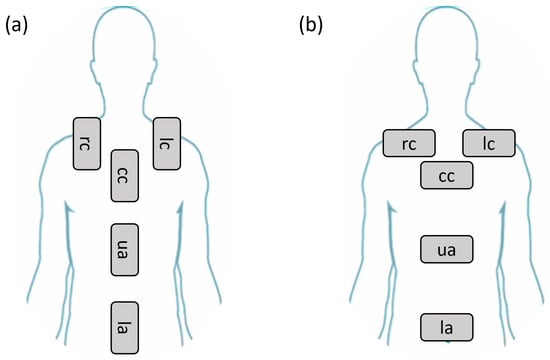
Figure 2.
Prescribed positions for smartphone acquisition with vertical (a) and horizontal (b) orientation.
After each test session, the data from smartphone acquisitions were transferred to a computer for off-line processing. All the processing was carried out with a custom script in MATLAB (version 2023b). Data from both acquisition sessions were sampled with a frequency of 100 Hz. In particular, the three accelerometer () and gyroscope () signals were processed. For all the waveforms, the signal-to-noise ratio for accelerometers () and gyroscopes (), evaluated as a vector module in dB, was calculated according to:
where is the signal power calculated during the respiratory activity interval and is the noise power calculated during the zero-input reference interval. The signal and noise power were calculated according to:
where N is the number of samples in the interval, and is the waveform on the chosen interval (signal for the respiratory activity interval and noise for the zero-input reference interval). After calculation, the signals were analyzed in terms of artifacts presence. In particular, these two main steps were imposed: filtering and artifact individuation. For the filtering, a 4th-order Butterworth band-pass filter, with lower and upper frequencies of 0.1 Hz and 1 Hz [33], was imposed on the signal to remove the effects of high-frequency noise, low-frequency drifts, and sensor offsets. For the artifact removal, step-like and drift artifacts were individuated in the waveforms, as they were assumed to be linked with sensors sliding during the acquisition. The artifacts were detected by adopting a wavelet transform-based method [34].
2.2. Application Development
After the validation phase, a dedicated smartphone application for guiding the user through the acquisition procedure and for accelerometer and gyroscope signal acquisition was developed (Figure 3). The application was programmed to be compatible with the Android operating system. In particular, a multilingual application was created, written in the general-purpose Kotlin programming language, and based on a classic client–server architecture with representational state transfer interfaces. The client–server architecture was required to allow the data-sharing procedure, with the app serving as the client, while a central server takes on the server and database management roles.
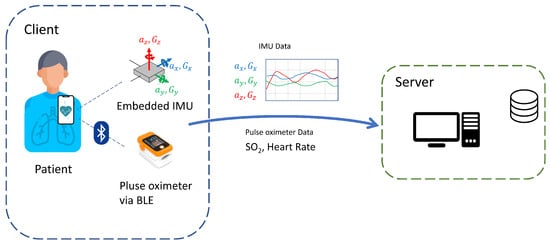
Figure 3.
Application server–client workflow for data sharing.
The application was programmed to ask the user to choose among the different measurement protocols, depending on the smartphone positioning. The app was developed in order to guide the user to correctly finalize the measurement with a sample video and prerecorded voice instructions. In particular, the voice instructions were added with the specific purpose of allowing the user to proceed with the acquisitions on their own, without the need to watch the smartphone screen directly. During the acquisition, the app would record the data from the embedded IMU in terms of accelerometer and gyroscope data. Additionally, the app was developed in order to communicate with an external pulse oximeter device via the Bluetooth Low Energy (BLE) protocol, thus enabling the correlation of the IMU measurements with blood oxygenation and heart rate data. At the end of each acquisition, the app was programmed to share the anonymized data with the server via network connection. Particular attention was given to the privacy requirements for the protection of sensitive data collected by the app. Given this aspect, the application was programmed to associate the measurement with anonymous identifiers rather than personal data.
The application was successfully finalized. In Figure 4, the position selection, the user identification, the sample video, and the acquisition interface are shown [35].
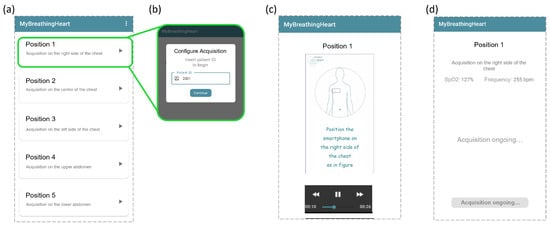
Figure 4.
Application interface examples: position selection (a), user identification (b), positioning sample video reproduction (c), and acquisition interface (d).
2.3. Signal Processing
After finalizing the application, a workflow for processing the IMU data was defined. The following processing operations were imposed on accelerometer signals : filtering, cycle identification, and reference system correction. For the filtering, the same method proposed in the validation phase of Section 2.1 was imposed. Specifically, the band-pass filter was applied to remove both noise and low frequency errors linked with unwanted body movements. For cycle identification, a peak detection algorithm was imposed on the channel linked with the maximum signal range to search for local minima. A single respiratory cycle was assumed to be included between two local minima of the main acceleration component (Figure 5).
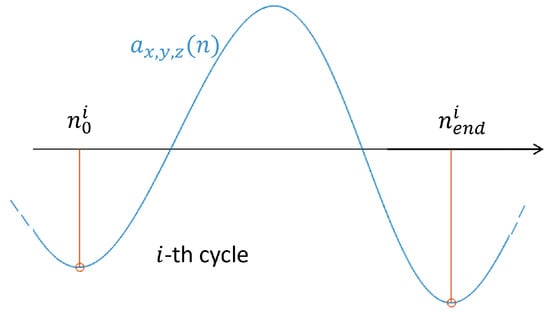
Figure 5.
Example of a single respiratory cycle identification.
The smartphone at these minima was assumed to be stationary and, consequently, acceleration components were assumed to be zero. To follow this assumption, the acceleration signals at the i-th cycle () were processed according to a linear drift correction:
where and are the time indexes of the beginning and end of the i-th respiratory cycle.
Before proceeding with reference system correction, angular velocities () from the gyroscope were processed. Briefly, band-pass filtering, as already imposed for the accelerometer signals, was adopted, and the cycles according to the already established local minima were individuated. Then, a linear correction like the one described in Equation (3) was imposed on each gyroscope signal at each respiratory cycle. Finally, a numerical integration process was imposed to obtain the orientation angles () from the angular velocities. In particular, the values were calculated according to:
At this point, it is possible to use the orientation angles to transform the acceleration components from the local reference system to the global reference system. Assumptions regarding smartphone orientation during the respiratory act were made. The assumptions are summarized in Figure 6. In particular, it was hypothesized that the smartphone orientation was the same at the beginning and at the end of each respiratory act, defined by the initial local reference system . On the basis of this, a linear correction analogous to the one expressed in Equation (3) was imposed on as well. At a given time point n within the i-th respiratory act, the smartphone orientation was defined according to the generic local reference system . A time-varying rotation matrix can be defined to convert the components from the local reference system at time n to the local reference system at time .

Figure 6.
Local reference system with rotation matrices for a respiratory act.
From the angle orientation estimation, the rotation matrix for each interval was defined by considering the roll (), pitch (), and yaw () angles [36] as:
where is a rotation matrix about the j-th axis. Finally, the time-varying rotation matrix of Equation (5) was applied to the acceleration components to calculate the acceleration in the reference system on the i-th interval as:
As an additional point, the accelerometer and gyroscope data were used, after the above-cited processing, as a tool to estimate the respiratory rate (RR) for each acquisition. In particular, the signal revealing the maximum range after filtering among and was selected. Then, the discrete Fourier transform was imposed on the selected signal () via the Fast Fourier Transform algorithm, according to:
where f is the frequency domain variable, and is the discrete Fourier transform of the signal. Given the semi-periodicity of the signal , the RR can be estimated by the first nonzero frequency corresponding to the maximum of .
2.4. Acquisition Campaign
After validating the acquisition protocol, developing the dedicated application, and defining the signal processing, a specific acquisition campaign was carried out. The campaign was defined to gather data from a population of healthy volunteers. A total of 77 subjects with no known respiratory or cardiovascular pathologies were recruited. The subject distribution in terms of age and Body Mass Index (BMI), with corresponding mean ± standard deviation (42 ± 11.5 years old and BMI of 23.2 ± 3.8) and sex, are reported in Figure 7.
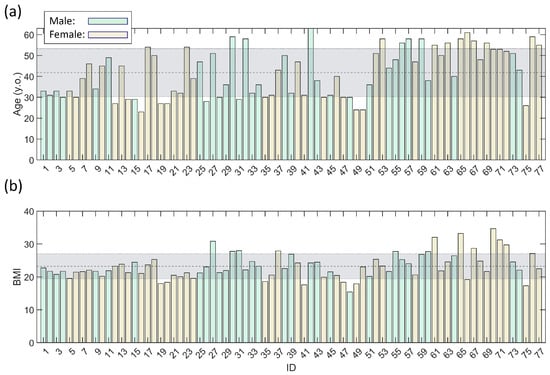
Figure 7.
Distribution in terms of age (a) and BMI (b) for the population of volunteers selected for the acquisition campaign. The mean ± standard deviation range is highlighted.
Specifically, the population was constituted by 33 males (41 ± 10.8 years old and BMI of 23.7 ± 3.0) and 44 females (42 ± 12.0 years old and BMI of 23.0 ± 4.3). All participants were fully informed about the purpose of the study, and informed consent documentation was obtained from all. Before starting the procedure, each user was trained in terms of application usage and asked to proceed with the acquisitions on their own under the supervision of the operators. The IMU signals for all the prescribed positions were processed for all the subjects according to the procedure summarized in Section 2.3. During the acquisition campaign, the users were asked to rate the application’s usability on a scale from 1 (worst score) to 5 (best score). Additionally, statistical significance was evaluated according to patient sex, prescribed smartphone position, and the three main vector components of the accelerometer–gyroscope sensors. In particular, the statistical significance tests were carried out in terms of maximum range of each accelerometer () and gyroscope (). The significance of the differences for all the above-cited parameters was assessed via two-sample Kolmogorov–Smirnov tests. All the tests were carried out with a significance level of .
As an additional point for the acquisition campaign, the RR was calculated for each subject according to the method described previously in Section 2.3.
3. Results
Concerning the validation phase, the preliminary data gathering campaign was successful. The and values are reported in Table 1 for each of the five positions with both vertical and horizontal orientations.

Table 1.
values from the validation phase in the 10 prescribed smartphone configurations (five positions and two orientations).
The artifact detection protocol imposed in this phase revealed the presence of drifting artifacts in the acquisitions of positions with vertical orientation (Figure 2a). An example of these events, occurring at position , is shown in Figure 8 before and after filtering. From the preliminary validation campaign, drifting artifacts appeared on 26% of the acquisitions with a vertical orientation. For this reason, only positions with a horizontal orientation were carried out in the successive acquisition campaign.
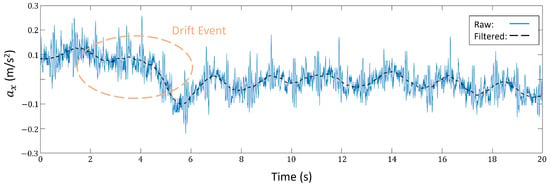
Figure 8.
Example of drifting event in signal during the preliminary acquisition campaign, at position and with a vertical orientation.
Concerning the campaign, the acquisitions were successful for the volunteers. The five positions , , , , and were recorded for all cases. The distribution in terms of application usability score, on the basis of the volunteers’ evaluation, is reported in Figure 9, with the mean ± standard deviation (4.0 ± 0.6) highlighted. The distributions in terms of ranges of accelerations and gyroscopes are reported in the box plots of Figure 10 and Figure 11. In particular, the data were subdivided into male and female volunteers in Figure 10, while the overall distributions are presented in Figure 11. In Figure 10, the components exhibiting a significant difference between male and female populations were highlighted with an asterisk. For both figures, the box plot data were grouped according to smartphone positions.

Figure 9.
Distribution in terms of usability score for the population of volunteers selected for the acquisition campaign. The mean ± standard deviation range is highlighted.

Figure 10.
Box plots for male and female populations in terms of acceleration ranges (a) and angular speed ranges (b), grouped according to different smartphone positions. Significant differences () are reported with an asterisk.
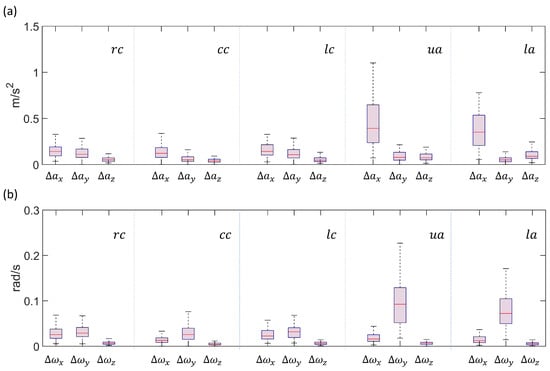
Figure 11.
Box plots for the overall population in terms of acceleration ranges (a) and angular speed ranges (b), grouped according to different smartphone positions.
The results of Kolmogorov–Smirnov tests were reported in terms of over–under threshold p-values. In particular, Figure 12 schematizes the p-values to assess the statistical significance of differences between the main components of acceleration (Figure 12a) and gyroscope (Figure 12b) vector component ranges. Similarly, the results of statistical significance of the different smartphone positions are summarized in Figure 13 in terms of acceleration (Figure 13a) and gyroscope (Figure 13b) vector component ranges. For all the schemes of Figure 12 and Figure 13, light squares are used to highlight statistically significant differences ().
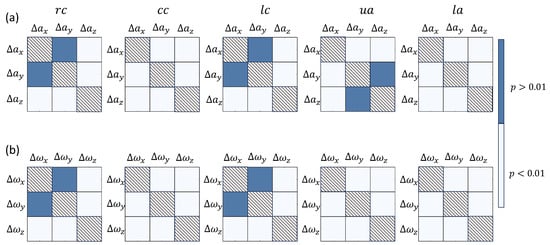
Figure 12.
Tables of p-values from Kolmogorov–Smirnov tests to assess statistical significance of signal vector components in terms of (a) and (b).
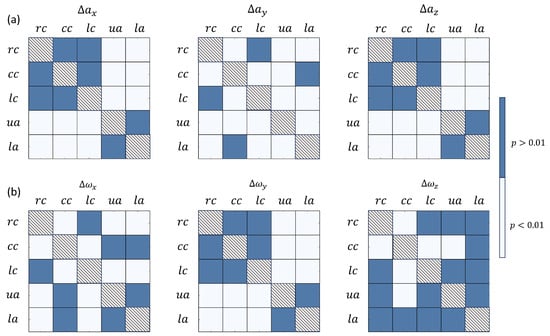
Figure 13.
Tables of p-values from Kolmogorov–Smirnov tests to assess statistical significance of smartphone position in terms of (a) and (b).
Concerning the RR estimation, the distribution, with values in acts per minute (apm), is reported in Figure 14, with the mean ± standard deviation (23.2 ± 4.8 apm) highlighted.
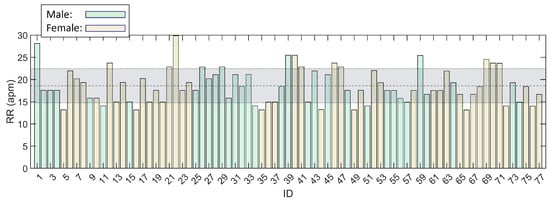
Figure 14.
Distribution in terms of RR for the population of volunteers selected for the acquisition campaign. The mean ± standard deviation range is highlighted.
4. Discussion
The results presented in the previous section demonstrate the feasibility of the new procedure for remote respiratory monitoring. In particular, it was demonstrated that the novel smartphone-based acquisition method for chest–abdomen respiratory kinematics was suitable for the task, thanks to the validation procedure imposed. A dedicated application was developed with success, and the acquisition campaign was carried out on a relevant number of volunteer cases. The acquisition campaign revealed significant differences in terms of participant sex, vector components, and smartphone positions.
Concerning the first validation phase, and were successfully calculated for a preliminary number of subjects, as presented in Table 1. The values reported from the different smartphone positions were contained within the 19–26 dB range, which are acceptable for signal evaluation. The values contained in Table 1 confirm the feasibility of adopting all smartphone positions in both orientations to record respiratory kinematics. The values of demonstrate the possibility of detecting respiratory kinematics with the proposed procedure. It was observed that smartphone slipping can occur in the vertical orientation. The artifact detection process during the validation phase revealed signal drifting phenomena for 26% of the acquisitions, as reported in the example of Figure 8. Given the results of the preliminary validation phase, the subsequent acquisition campaign was carried out by adopting horizontal orientations only.
Concerning the acquisition campaign, 77 healthy volunteers were recruited. The scores in terms of the application’s usability were satisfactory (Figure 9), with a mean score of 4.0 ± 0.6 on a scale from 1 to 5.
The distributions for the male and female sub-populations of and were obtained (Figure 10). The statistical tests concluded that, for the , , , and positions, no significant difference existed according to the subjects’ sex. On the contrary, as highlighted in Figure 10, a score was produced for , , and for the position. These results denote the statistical difference between male and female subjects for the above-cited position. This highlighted aspect appears to be in accordance with the difference in the respiratory nature of males and females linked with diaphragm movement, as already reported in study [37]. Moreover, the ranges of accelerometer measurements reported in Figure 10 are in line with values from the literature concerning acquisitions in the abdominal area [38].
The overall distributions of and were obtained (Figure 11). The statistical significance of the different vector components in the five positions was assessed (Figure 12). In particular, the and positions reveal similar behaviors in terms of both accelerations and angular velocities, with z components being significantly lower than both x and y components. The and positions, instead, reveal significant differences between all components for both acceleration and angular velocities, with higher values for and , respectively. Finally, the position exhibits a single dominant component in terms of acceleration () and differences between all the different components in terms of angular velocities. These data highlight a relevant concept: lateral chest positions ( and ) exhibited non-negligible acceleration components and rotations on the chest plane, while the , , and usually exhibited a single dominant component, which is in line with the central nature of their location. These data suggest that respiratory kinematics are more complex at the lateral chest level, where multiple degrees of freedom are covered [31,32]. In general, the differences emerging from the comparison of the prescribed smartphone positions demonstrate the possibility of detecting several components of respiratory kinematics linked with chest and abdomen displacement.
The statistical significance of the different smartphone positions used during the acquisition campaign was assessed (Figure 13). In particular, it appears that the components acquired on the chest (, , and ) are always significantly lower than the ones acquired on the abdomen ( and ) for the , , and components. This aspect underlines the different nature of respiration on the basis of the acquisition position, as acceleration ranges suggest a higher excursion in the abdomen area, which is characteristic of normal, healthy breathing [39,40]. For the and components, no significant difference emerged by comparing and lateral chest positions and by comparing and . This last trend confirms the similar nature of both lateral chest positions, in which the and components are not negligible, and the similar nature of and , both being central positions for the acquisition. Finally, for the component, statistically relevant differences emerged from the position only. Nevertheless, it is possible to observe that the ranges were always limited in comparison to the other gyroscope components (see also Figure 11b) and, for this reason, the differences were not considered relevant.
Finally, the RR was calculated for all the subjects from the signal acquired during the campaign (Figure 14). The reported mean ± standard deviation values are 18.6 ± 3.8 apm, which fall within in the physiological range according to the literature [41].
The current work presents a new approach for the remote monitoring of respiratory kinematics via smartphone-embedded sensors. The state of the art already reports similar methodologies; however, most of them rely on the adoption of wireless communication with standalone transducers and wearable devices [26,27], or they are extremely focused on the estimation of RR only [28], without a deep investigation into the effect of different device positions on the chest–abdomen. In fact, although smartphone-embedded IMUs are adopted in a few cases for respiratory kinematics recording, they are used to monitor a limited set of positions, neglecting the chest–abdomen kinematic difference [28,29]. To our knowledge, this is the first contribution proposing a complete study of the effect of device positioning and the monitoring of both chest and abdomen kinematics via multiple positions acquired through a smartphone. The reported acceleration and gyroscope signal ranges from the acquisition campaign were in line with alternative IMU-based approaches for respiratory monitoring reported in the literature [24,42,43], and the RR estimation was also satisfactory, with values falling in the physiological range [41]. This evidence confirms our method as an innovative approach for the potential remote monitoring of breathing activity, based on embedded transducers only, and without the need for the adoption of specific standalone sensors. The alternative given by wearable standalone sensors implies higher costs in terms of power and hardware requirements, while the adoption of smartphones only presents advantages in terms of wide availability and ease of use.
The presented work exhibits points of limitation and future work opportunities. A validation of the smartphone-based acquisition of the respiratory movement through optical-based gold standard methods is still lacking in the presented work. Nevertheless, the feasibility of the acquisition procedure was demonstrated by revealing satisfactory levels of and significant differences in the main accelerometer and angular velocity components. The study did not foresee the adoption of the application for actual remote monitoring, as the users during the acquisition campaign were partially supervised by the operators. Nevertheless, the users were asked to proceed with the acquisition on their own, and the application was deemed as satisfactory in terms of usage according to the reported scores, thanks to the application sample videos and prerecorded voice instructions. The presented work has the potential to be used to gather a significant volume of data given the widespread nature of smartphone diffusion. The current procedure requires the user to remain in a supine position to allow for correct acquisition. In future developments of the workflow, it may be interesting to validate acquisitions for other subject postures, with the possible adoption of elastic strips to support the smartphone. The current work was limited to the involvement of healthy subjects only. It would be interesting in the future to include pathological subjects with known respiratory diseases or under a post-surgery rehabilitation regime into the recruitment study.
5. Conclusions
In this manuscript, a new method for the acquisition of respiratory kinematics signals via smartphone was presented. The feasibility of the presented methodology was demonstrated, and a total of five smartphone positions, covering both the chest and the abdomen, was defined. After the validation, an acquisition campaign was carried out with success on a healthy subject population. The gathered data revealed significant differences among the different acquisition positions, with the possibility of distinguishing features of chest and abdomen kinematics during the respiratory acts. The study represents a first step towards a new approach for remote respiratory monitoring based on smartphone acquisitions. The current work opens pathways for subsequent developments. The workflow can be potentially adopted to acquire significant data volumes, given the widespread nature of smartphone diffusion, suitable for further processing. In the future, the workflow could be applied for monitoring pathological subjects as well.
Author Contributions
Conceptualization, S.C., V.G., D.H. and S.B.; methodology, E.V. and E.G.; software, E.V., E.G., L.M. and V.G.; validation, E.V. and E.G.; formal analysis, E.V. and E.G.; investigation, E.V., E.G. and S.C.; resources, E.V., E.G., D.H., L.F., G.B. and S.B.; data curation, E.V., E.G., L.M. and L.S.; writing—original draft preparation, E.V. and E.G.; writing—review and editing, E.V., E.G., S.C., L.M., V.G. and L.S.; visualization, E.V., E.G., S.C. and V.G.; supervision, S.C. and V.G.; project administration, S.C., V.G., L.F. and S.B.; funding acquisition, V.G., L.F. and S.B. All authors have read and agreed to the published version of the manuscript.
Funding
This research was funded by Bando Regionale Ricerca COVID 19 Toscana—Progetto MyBreathingHeart CUP n J64G200038001.
Institutional Review Board Statement
The study was conducted in accordance with the Declaration of Helsinki and approved by the Ethics Committee of Comitato Etico Regionale per la Sperimentazione Clinica della Regione Toscana Sezione: AREA VASTA NORD OVEST protocol code: 20417_BERTI, date of approval: 24 February 2022.
Informed Consent Statement
Informed consent was obtained from all subjects involved in the study.
Data Availability Statement
The data presented in this study are available, on reasonable request, from the corresponding author.
Conflicts of Interest
The authors declare no conflicts of interest.
Abbreviations
The following abbreviations are used in this manuscript:
| accelerometer components | |
| apm | acts per minute |
| BLE | Bluetooth Low Energy |
| BMI | Body Mass Index |
| ECG | electrocardiogram |
| chest central | |
| IMU | inertial measurement unit |
| lower abdomen | |
| left chest | |
| right chest | |
| RR | respiratory rate |
| signal-to-noise ratio | |
| upper abdomen | |
| gyroscope components |
References
- Mohammed, K.; Zaidan, A.; Zaidan, B.; Albahri, O.S.; Alsalem, M.; Albahri, A.S.; Hadi, A.; Hashim, M. Real-time remote-health monitoring systems: A review on patients prioritisation for multiple-chronic diseases, taxonomy analysis, concerns and solution procedure. J. Med. Syst. 2019, 43, 223. [Google Scholar] [CrossRef] [PubMed]
- Dawes, A.; Lin, A.; Varghese, C.; Russell, M.; Lin, A. Mobile health technology for remote home monitoring after surgery: A meta-analysis. Br. J. Surg. 2021, 108, 1304–1314. [Google Scholar] [CrossRef] [PubMed]
- Shaji, S.; Pathinarupothi, R.K.; Rangan, E.S.; Menon, K.U.; Ramesh, M.V. Heart lung health monitor: Remote at-home patient surveillance for pandemic management. In Proceedings of the 2021 IEEE Global Humanitarian Technology Conference (GHTC), Seattle, WA, USA, 19–23 October 2021; pp. 127–130. [Google Scholar]
- Vedaei, S.S.; Fotovvat, A.; Mohebbian, M.R.; Rahman, G.M.; Wahid, K.A.; Babyn, P.; Marateb, H.R.; Mansourian, M.; Sami, R. COVID-SAFE: An IoT-based system for automated health monitoring and surveillance in post-pandemic life. IEEE Access 2020, 8, 188538–188551. [Google Scholar] [CrossRef] [PubMed]
- Magnocavallo, M.; Vetta, G.; Bernardini, A.; Piro, A.; Mei, M.C.; Di Iorio, M.; Mariani, M.V.; Della Rocca, D.G.; Severino, P.; Quaglione, R.; et al. Impact of COVID-19 pandemic on cardiac electronic device management and role of remote monitoring. Card. Electrophysiol. Clin. 2022, 14, 125–131. [Google Scholar] [CrossRef] [PubMed]
- Strik, M.; Caillol, T.; Ramirez, F.D.; Abu-Alrub, S.; Marchand, H.; Welte, N.; Ritter, P.; Haïssaguerre, M.; Ploux, S.; Bordachar, P. Validating QT-interval measurement using the Apple Watch ECG to enable remote monitoring during the COVID-19 pandemic. Circulation 2020, 142, 416–418. [Google Scholar] [CrossRef] [PubMed]
- Alugubelli, N.; Abuissa, H.; Roka, A. Wearable Devices for Remote Monitoring of Heart Rate and Heart Rate Variability—What We Know and What Is Coming. Sensors 2022, 22, 8903. [Google Scholar] [CrossRef] [PubMed]
- Turakhia, M.P.; Desai, M.; Hedlin, H.; Rajmane, A.; Talati, N.; Ferris, T.; Desai, S.; Nag, D.; Patel, M.; Kowey, P.; et al. Rationale and design of a large-scale, app-based study to identify cardiac arrhythmias using a smartwatch: The Apple Heart Study. Am. Heart J. 2019, 207, 66–75. [Google Scholar] [CrossRef]
- Golinelli, D.; Boetto, E.; Carullo, G.; Nuzzolese, A.G.; Landini, M.P.; Fantini, M.P. Adoption of digital technologies in health care during the COVID-19 pandemic: Systematic review of early scientific literature. J. Med. Internet Res. 2020, 22, e22280. [Google Scholar] [CrossRef]
- Beduk, T.; Beduk, D.; Hasan, M.R.; Guler Celik, E.; Kosel, J.; Narang, J.; Salama, K.N.; Timur, S. Smartphone-based multiplexed biosensing tools for health monitoring. Biosensors 2022, 12, 583. [Google Scholar] [CrossRef]
- Alzughaibi, A.A.; Ibrahim, A.M.; Na, Y.; El-Tawil, S.; Eltawil, A.M. Community-Based Multi-Sensory Structural Health Monitoring System: A Smartphone Accelerometer and Camera Fusion Approach. IEEE Sens. J. 2021, 21, 20539–20551. [Google Scholar] [CrossRef]
- Brown, C.; Chauhan, J.; Grammenos, A.; Han, J.; Hasthanasombat, A.; Spathis, D.; Xia, T.; Cicuta, P.; Mascolo, C. Exploring automatic diagnosis of COVID-19 from crowdsourced respiratory sound data. In Proceedings of the 26th ACM SIGKDD International Conference on Knowledge Discovery & Data Mining, Virtual Event, 6–10 July 2020; pp. 3474–3484. [Google Scholar]
- Kvapilova, L.; Boza, V.; Dubec, P.; Majernik, M.; Bogar, J.; Jamison, J.; Goldsack, J.C.; Kimmel, D.J.; Karlin, D.R. Continuous sound collection using smartphones and machine learning to measure cough. Digit. Biomark. 2020, 3, 166–175. [Google Scholar]
- Nascimento, L.M.S.d.; Bonfati, L.V.; Freitas, M.L.B.; Mendes Junior, J.J.A.; Siqueira, H.V.; Stevan, S.L., Jr. Sensors and systems for physical rehabilitation and health monitoring—A review. Sensors 2020, 20, 4063. [Google Scholar] [CrossRef] [PubMed]
- Halloran, S.; Tang, L.; Guan, Y.; Shi, J.Q.; Eyre, J. Remote monitoring of stroke patients’ rehabilitation using wearable accelerometers. In Proceedings of the 2019 ACM International Symposium on Wearable Computers, London, UK, 9–13 September 2019; pp. 72–77. [Google Scholar]
- Aliverti, A.; Lacca, D.; LoMauro, A. Quantitative Analysis by 3D Graphics of Thoraco-Abdominal Surface Shape and Breathing Motion. Front. Bioeng. Biotechnol. 2022, 10, 910499. [Google Scholar] [CrossRef]
- Bianchi, R.; Gigliotti, F.; Romagnoli, I.; Lanini, B.; Castellani, C.; Binazzi, B.; Stendardi, L.; Grazzini, M.; Scano, G. Patterns of chest wall kinematics during volitional pursed-lip breathing in COPD at rest. Respir. Med. 2007, 101, 1412–1418. [Google Scholar] [CrossRef] [PubMed]
- Takashima, S.; Nozoe, M.; Mase, K.; Kouyama, Y.; Matsushita, K.; Ando, H. Effects of posture on chest-wall configuration and motion during tidal breathing in normal men. J. Phys. Ther. Sci. 2017, 29, 29–34. [Google Scholar] [CrossRef] [PubMed]
- Tukanova, K.; Papi, E.; Jamel, S.; Hanna, G.B.; McGregor, A.H.; Markar, S.R. Assessment of chest wall movement following thoracotomy: A systematic review. J. Thorac. Dis. 2020, 12, 1031. [Google Scholar] [CrossRef] [PubMed]
- Grimby, G.; Fugl-Meyer, A.R.; Blomstrand, A. Partitioning of the contributions of rib cage and abdomen to ventilation in ankylosing spondylitis. Thorax 1974, 29, 179–184. [Google Scholar] [CrossRef][Green Version]
- Lunardi, A.C.; Miranda, C.S.; Silva, K.M.; Cecconello, I.; Carvalho, C.R. Weakness of expiratory muscles and pulmonary complications in malnourished patients undergoing upper abdominal surgery. Respirology 2012, 17, 108–113. [Google Scholar] [CrossRef]
- Kristjánsdóttir, Á.; Ragnarsdóttir, M.; Hannesson, P.; Beck, H.J.; Torfason, B. Respiratory movements are altered three months and one year following cardiac surgery. Scand. Cardiovasc. J. 2004, 38, 98–103. [Google Scholar] [CrossRef]
- Monaco, V.; Giustinoni, C.; Ciapetti, T.; Maselli, A.; Stefanini, C. Assessing Respiratory Activity by Using IMUs: Modeling and Validation. Sensors 2022, 22, 2185. [Google Scholar] [CrossRef]
- Massaroni, C.; Nicolò, A.; Lo Presti, D.; Sacchetti, M.; Silvestri, S.; Schena, E. Contact-based methods for measuring respiratory rate. Sensors 2019, 19, 908. [Google Scholar] [CrossRef] [PubMed]
- De la Fuente, C.; Weinstein, A.; Guzman-Venegas, R.; Arenas, J.; Cartes, J.; Soto, M.; Carpes, F.P. Use of accelerometers for automatic regional chest movement recognition during tidal breathing in healthy subjects. J. Electromyogr. Kinesiol. 2019, 47, 105–112. [Google Scholar] [CrossRef] [PubMed]
- Angelucci, A.; Camuncoli, F.; Galli, M.; Aliverti, A. A wearable system for respiratory signal filtering based on activity: A preliminary validation. In Proceedings of the 2022 IEEE International Workshop on Sport, Technology and Research (STAR), Cavalese, Italy, 13–15 July 2022; pp. 19–23. [Google Scholar]
- Escobedo, P.; Bhattacharjee, M.; Nikbakhtnasrabadi, F.; Dahiya, R. Smart bandage with wireless strain and temperature sensors and batteryless NFC tag. IEEE Internet Things J. 2020, 8, 5093–5100. [Google Scholar] [CrossRef]
- Valentine, S.; Cunningham, A.C.; Klasmer, B.; Dabbah, M.; Balabanovic, M.; Aral, M.; Vahdat, D.; Plans, D. Smartphone movement sensors for the remote monitoring of respiratory rates: Technical validation. Digit. Health 2022, 8, 20552076221089090. [Google Scholar] [CrossRef]
- Aly, H.; Youssef, M. Zephyr: Ubiquitous accurate multi-sensor fusion-based respiratory rate estimation using smartphones. In Proceedings of the IEEE INFOCOM 2016-The 35th Annual IEEE International Conference on Computer Communications, San Francisco, CA, USA, 10–14 April 2016; pp. 1–9. [Google Scholar]
- Ladjal, H.; Shariat, B.; Azencot, J.; Beuve, M. Appropriate biomechanics and kinematics modeling of the respiratory system: Human diaphragm and thorax. In Proceedings of the 2013 IEEE/RSJ International Conference on Intelligent Robots and Systems, Tokyo, Japan, 3–7 November 2013; pp. 2004–2009. [Google Scholar]
- Torres-Tamayo, N.; García-Martínez, D.; Lois Zlolniski, S.; Torres-Sánchez, I.; García-Río, F.; Bastir, M. 3D analysis of sexual dimorphism in size, shape and breathing kinematics of human lungs. J. Anat. 2018, 232, 227–237. [Google Scholar] [CrossRef] [PubMed]
- Shaw, B.S.; Shaw, I. Pulmonary function and abdominal and thoracic kinematic changes following aerobic and inspiratory resistive diaphragmatic breathing training in asthmatics. Lung 2011, 189, 131–139. [Google Scholar] [CrossRef] [PubMed]
- Rousanoglou, E.; Foskolou, A.; Emmanouil, A.; Boudolos, K. Inertial Sensing of the Abdominal Wall Kinematics during Diaphragmatic Breathing in Head Standing. Biomechanics 2024, 4, 63–83. [Google Scholar] [CrossRef]
- Yang, L.; Qu, S.; Zhang, Y.; Zhang, G.; Wang, H.; Yang, B.; Xu, C.; Dai, M.; Cao, X. Removing clinical motion artifacts during ventilation monitoring with electrical impedance tomography: Introduction of methodology and validation with simulation and patient data. Front. Med. 2022, 9, 817590. [Google Scholar] [CrossRef]
- Simone, L.; Miglior, L.; Gervasi, V.; Moroni, L.; Vignali, E.; Gasparotti, E.; Celi, S. Early Screening of Cardiorespiratory Diseases Through Smartphone IMU Sensors and Bidirectional LSTM. Available online: http://dx.doi.org/10.2139/ssrn.4676194 (accessed on 13 March 2024).
- Candan, B.; Soken, H.E. Robust attitude estimation using IMU-only measurements. IEEE Trans. Instrum. Meas. 2021, 70, 1–9. [Google Scholar] [CrossRef]
- Romei, M.; Mauro, A.L.; D’angelo, M.; Turconi, A.; Bresolin, N.; Pedotti, A.; Aliverti, A. Effects of gender and posture on thoraco-abdominal kinematics during quiet breathing in healthy adults. Respir. Physiol. Neurobiol. 2010, 172, 184–191. [Google Scholar] [CrossRef]
- Erfianto, B.; Rizal, A. IMU-Based Respiratory Signal Processing Using Cascade Complementary Filter Method. J. Sens. 2022, 2022, 7987159. [Google Scholar] [CrossRef]
- Sikora, M.; Mikołajczyk, R.; Łakomy, O.; Karpiński, J.; Żebrowska, A.; Kostorz-Nosal, S.; Jastrzębski, D. Influence of the breathing pattern on the pulmonary function of endurance-trained athletes. Sci. Rep. 2024, 14, 1113. [Google Scholar] [CrossRef]
- Kiesel, K.; Rhodes, T.; Mueller, J.; Waninger, A.; Butler, R. Development of a screening protocol to identify individuals with dysfunctional breathing. Int. J. Sport. Phys. Ther. 2017, 12, 774. [Google Scholar] [CrossRef]
- Russo, M.A.; Santarelli, D.M.; O’Rourke, D. The physiological effects of slow breathing in the healthy human. Breathe 2017, 13, 298–309. [Google Scholar] [CrossRef]
- De Fazio, R.; Greco, M.R.; De Vittorio, M.; Visconti, P. A Differential Inertial Wearable Device for Breathing Parameter Detection: Hardware and Firmware Development, Experimental Characterization. Sensors 2022, 22, 9953. [Google Scholar] [CrossRef] [PubMed]
- Vertens, J.; Fischer, F.; Heyde, C.; Hoeflinger, F.; Zhang, R.; Reindl, L.M.; Gollhofer, A. Measuring Respiration and Heart Rate using Two Acceleration Sensors on a Fully Embedded Platform. In Proceedings of the icSPORTS, Lisbon, Portugal, 15–17 November 2015; pp. 15–23. [Google Scholar]
Disclaimer/Publisher’s Note: The statements, opinions and data contained in all publications are solely those of the individual author(s) and contributor(s) and not of MDPI and/or the editor(s). MDPI and/or the editor(s) disclaim responsibility for any injury to people or property resulting from any ideas, methods, instructions or products referred to in the content. |
© 2024 by the authors. Licensee MDPI, Basel, Switzerland. This article is an open access article distributed under the terms and conditions of the Creative Commons Attribution (CC BY) license (https://creativecommons.org/licenses/by/4.0/).